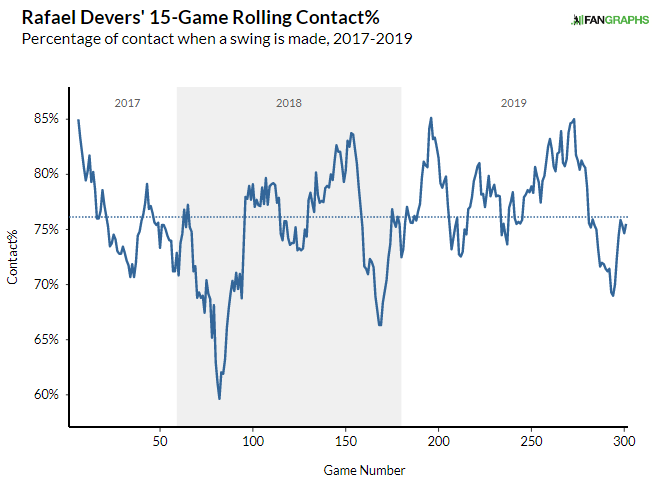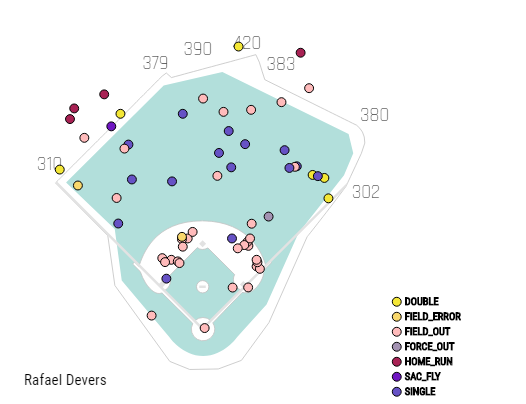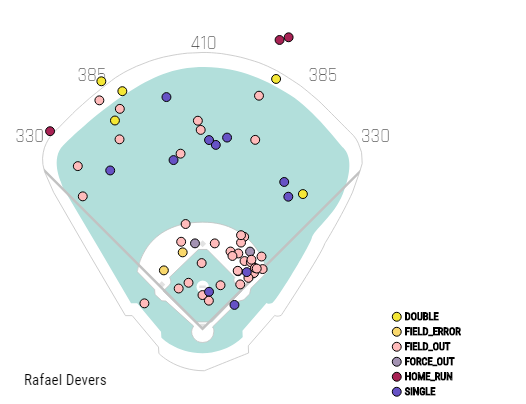This article is part of our Collette Calls series.
Rafael Devers had a monster week against Cleveland and Baltimore pitching, hitting .593/.633/1.185 with three home runs, seven runs scored and 11 runs driven in. He had 32 total bases this week; the Royals had 36 as a team.
It has been like this nearly all season for the 22-year-old wunderkind. He has 27 homers, 103 runs scored, 101 runs driven in , eight steals (caught eight times too!) and owns a .332/.380/.596 batting line. Our Earned Auction Value Calculator has him at $42 in standard mixed leagues heading into Monday, trailing only Christian Yelich, Ronald Acuna, Cody Bellinger and Mike Trout. By ADP, those players went seventh, eighth, 44th, 1st ... and 145th in drafts this year.
The return on investment for everyone who rostered Devers ($17 for my AL Tout Wars team!) has been fantastic. The question is, what did Devers do to change his fortunes after the .240/.298/.433 struggles as a sophomore in 2018?
The easy answer would be to just say Devers was the latest example of how the Sophomore Slump theory can take down the best of them. He spent the 2018 season at the major league level and did not turn 22 until deep into the postseason. Most players his age are playing in the bush leagues in single-A, but Devers already has one World Series ring on his hand.
This 2019 breakout did not take long to notice as he has raked all season. One thing he was quick
Rafael Devers had a monster week against Cleveland and Baltimore pitching, hitting .593/.633/1.185 with three home runs, seven runs scored and 11 runs driven in. He had 32 total bases this week; the Royals had 36 as a team.
It has been like this nearly all season for the 22-year-old wunderkind. He has 27 homers, 103 runs scored, 101 runs driven in , eight steals (caught eight times too!) and owns a .332/.380/.596 batting line. Our Earned Auction Value Calculator has him at $42 in standard mixed leagues heading into Monday, trailing only Christian Yelich, Ronald Acuna, Cody Bellinger and Mike Trout. By ADP, those players went seventh, eighth, 44th, 1st ... and 145th in drafts this year.
The return on investment for everyone who rostered Devers ($17 for my AL Tout Wars team!) has been fantastic. The question is, what did Devers do to change his fortunes after the .240/.298/.433 struggles as a sophomore in 2018?
The easy answer would be to just say Devers was the latest example of how the Sophomore Slump theory can take down the best of them. He spent the 2018 season at the major league level and did not turn 22 until deep into the postseason. Most players his age are playing in the bush leagues in single-A, but Devers already has one World Series ring on his hand.
This 2019 breakout did not take long to notice as he has raked all season. One thing he was quick to point out was eating less Chipotle and hiring a nutritionist to help him eat better and keep off the weight that he added throughout the 2018 season. Getting in better shape is not the magic tonic for everyone; Matt Duffy added nearly 20 pounds this winter to hit the ball with more authority and he currently has the longest streak in the majors without a home run.
To get the results Devers is achieving in 2019, there has to be systematic changes in his approach. I will not pretend to know enough about hitting mechanics to get into stills of how he may have tweaked his swing, but we can look into some numbers to look for different behaviors at the plate.
In the same article where Devers discussed controlling his love for Chipotle, he also talked about changing his approach at the plate with two strikes:
I'm just trying to shorten up my swing with two strikes now," Devers said. "And just trying to put the ball in play with two strikes to make things happen."
The difficulty in hitting with two strikes is overlooked. You have to find an even finer balance between take mode and swing mode, and also be wary of the ever-changing strike zone depending on which umpire is behind the plate on a given night. The league-wide triple-slash in two-strike counts in 2019 is .175/.249/.289 with 42 percent of two-strike counts resulting in a strikeout. Devers was not exactly a slouch in two-strike counts in 2018 as 12 of his 21 home runs last year came in such counts. The trouble was it was mostly home run or strikeout as Devers struck out 48 percent of the time once the count got to two strikes in 2018, up slighly from the 46 percent rate in his rookie season. This season, things are a bit different as he has raised his two-strike batting average 30 points from last season (.198 to .228) and has cut his strikeout rate to 33 percent.
That strikeout rate is the one particular area I would like to focus on with Devers because it has been the most noticeable difference in his game this season.

The improvements in his two-strike approach have led to an overall improvement in his ability to make contact. You can see that for most of 2017 and 2018, he was below the league average in overall contact, but has lived above that line for most of the 2019 season. He has such tremendous plate coverage, he even finds success out of the zone. One thing that helps Devers is Fenway Park, but not in the way you may think.
The left-on-left matchup is a dreaded matchup, but when left field is cozy as is the case at Fenway, it allows Devers to wait on the ball and hit it with authority in the other direction. Last season, he hit .229 against lefties with a 25 percent strikeout rate. This season, he has hit .288 against lefties with a 20 percent strikeout rate. However, the fun begins when you split that up between home and away:
| STAT | HOME | AWAY |
| BA | .338 | .241 |
| OBP | .342 | .268 |
| SLG | .581 | .418 |
That is using a home-field advantage to one's advantage. The ability to stay back on the ball and drive it the other way in Fenway leads to extra base hits whereas that same approach leads to flyball outs in others. Note his spray chart against lefties while hitting in Fenway this season:

Now, compare that to his spray chart when hitting against lefties on the road in any other park (KC used due to its generic dimensions):

There is a noticeable grouping of pulled balls to the right side that is not present when he hits at Fenway. It should not surprise us that Fenway is a benefit to hitters, but I find it interesting how Devers in particular uses its dimensions to his advantage in lefty matchups and has a definitive change in approach than he does on the road.
I came into this article expecting to find more magic sauce in what Devers is doing differently in 2019, but there is nothing terribly surprising. He is making more contact, his average exit velocity is increased two miles an hour over 2018, and he (like just about everyone else) is hitting the ball further this year. The expected stats say he is overperforming his overall numbers, which is to be expected given how red-hot he has been at the plate this season.
Heading into Sunday, Devers has had 324 runners on base when he has hit, and 74 of those — 23 percent — have scored when he was at the plate. (Min 250 PA) Only Josh Phegley, DJ LeMahieu, Daniel Murphy and Eric Hosmer has driven in a higher percentage of runners this season. Devers has scored over 100 runs as well thanks to hitting high in a loaded lineup that scores as many runs as its pitchers give up.
Simply put, Devers is going to be a cornerstone player for Boston and for fantasy teams in the future. He is on pace to join Matt Holliday, Albert Pujols, Todd Helton, Alex Rodriguez, Albert Belle, Frank Robinson, Hank Greenberg, Chuck Klein and Lou Gehrig as the only players to have at least 50 doubles, 30 homers, 120 runs and 120 RBIs. If that does not put his production in proper perspective, nothing will.










